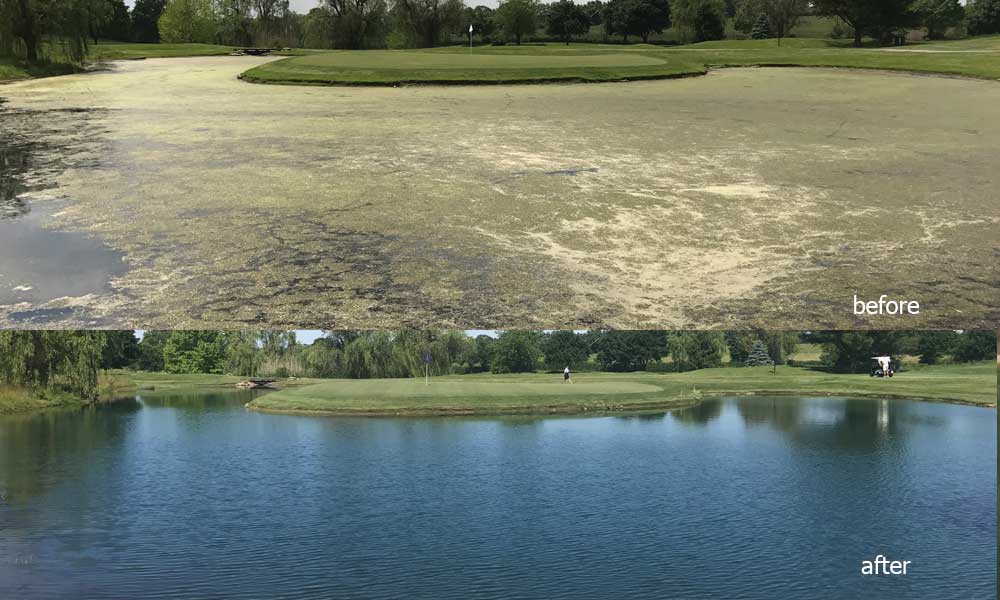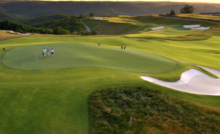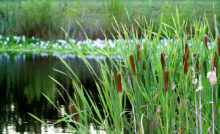Aquatic Control


It’s 170 yards to the pin but, lo and behold, between me and the flagstick is a pond. But not just any pond. From the elevated tee it looks like a scum-covered slime hole; a messy, monstrous looking thing that’s been invaded by algae, duckweed, cattails, and other unruly plants only the experts have a name for. Nevertheless, I hoist one up into the air and say a prayer. My ball is poorly struck, the wind grabs it, and it plummets into the murky mess. I don’t even bother having a look for it. Given the disgusting odor emanating from the surface, getting close to the muddy banks could be a lethal endeavor. The pond (truly a water hazard) could certainly have used some Aquatic Control®.
At many golf courses – including the one described above – the water hazards can, at least from an aesthetic point of view, characterize a course. Ugly, poorly-managed water hazards do not enhance the experience. They can turn people away. And, of course, beautifully-maintained and managed water features do the opposite. They add to the allure and enjoyment of the course. Similar to the bunkers – and, of course, the turf itself – when the water hazards are maintained properly, the visual appeal and the playability of the golf course can improve dramatically.
Founded in 1966, Aquatic Control® is an industry-leading company that assists community associations, parks, estates, homeowners – and, yes, golf courses – with effective solutions in dealing with their lakes, ponds, and various water features. And, given the fact that the vast majority of golf courses have some type of water feature (chances are good you’ve also hit a few errant shots into a slime pit!), they’ve got a large base of potential customers in the golf industry. Not surprisingly, this is an important and growing market for the company.
Headquartered in Seymour, Indiana (they have additional service centers in Kentucky, Missouri, Tennessee, and Southwest Indiana, and Northern Indiana and work with clients throughout the United States), Aquatic Control® staff have over 500 years of total experience when it comes to managing lakes and ponds. Their professional staff includes fisheries biologists, factory-trained fountain specialists, and licensed aquatic applicators. Their services include vegetation management plans, treatment programs, fountain/aeration installations, fish population surveys, and lake/pond mapping.
“Golf course superintendents often run into difficulties when it comes to managing nuisance vegetation in their ponds and water features,” says Mathew Johnson, President of Aquatic Control®. “Unfortunately, they often avoid managing them all together. Water features are typically a major component to the landscape of a golf course. And turf crews spend hours maintaining greens, fairways, and tees. Why should the water hazards go unmanaged? It doesn’t make sense and yet many courses spend very little time and resources on this. Often it is a lack of information that is limiting management efforts in this area.”
When it comes to neglecting the ponds, Johnson often hears the same “excuse.” “Unfortunately, many people believe that if the ponds are used for watering the golf course, they cannot be treated or it will have adverse effects on the turf. This is not true,” says Johnson. “We have options within our product lines of algaecides, herbicides, lake dyes, and aeration systems do not have adverse effects on turf. Fish and other aquatic life are not adversely affected. It is absolutely possible to treat a water hazard and use that same water for irrigation purposes.”
Obviously, good aeration is a key component of water management and Aquatic Control® has many products and systems that can assist in this area. For example, they are a distributor for Aquamaster Fountains and Aerators, Otterbine, and Kasc, all leading manufacturers of quality fountains in North America. Regardless of the type of system you use, good aeration of the water – which will increase the dissolved oxygen levels, thus creating a healthy body of water – is paramount in ponds and lakes.
Depending on the goals, environmental restrictions, and budget of the golf course, there are a number of options available for courses that choose to work with Aquatic Control® in managing their water features. “Basically, we can take away all the guesswork and do all the maintenance ourselves via customized service contracts,” says Johnson. “This can include bi-weekly visits to ensure ponds and lakes are healthy and looking great. Our team of qualified service professionals will work with the turfgrass professionals and course superintendents to provide a maintenance plan that covers all the key aspects. For example, this plan could include the use of Aquashade lake dye to help control vegetation growth and significantly improve the aesthetics. Blue will enhance the beauty of the water. Black will enhance the reflective nature of the water and add more depth to the landscape. The options are vast.”
Not surprisingly, there is a “Do-It-Yourself” option that can be appealing for courses with a limited budget. Typically, in this scenario the golf course collects plant samples and/or submits images of the vegetation and sends them to Aquatic Control®. Aquatic Control® will then analyze and identify the problem vegetation and recommend a course of action. A management plan is then developed for the golf course staff to follow. Customer support is readily available by phone or email.
“We can solve any challenge that a golf course may face in trying to manage the water features on the golf course,” says Johnson. “We accept the challenge to make the water hazards look as good as the tees and greens!”
Regardless who does the work, regular maintenance of your ponds and lakes is the key component of golf course maintenance. Ultimately, of course, the decision is up to each individual course in terms of a treatment program. Doing nothing – and pretending your odorous “slime holes” don’t exist – should never be an option.
Andrew Penner is a freelance writer and photographer based in Calgary, Alberta, Canada. His work has appeared in many leading golf publications throughout North America, including Golf Magazine, Golf Digest, The Golf Channel, Golf Canada, and SCOREGolf Magazine. Contact Andrew at andpenner@shaw.ca
Recent Posts
South Carolina State Leaders Honor Green’s Superintendent Career
South Carolina’s House of Representatives today honored the career of golf course superintendent Chuck Green.…
Branson, Missouri: 5 Reasons Why it is a Must-Visit Travel and Golf Destination
Branson, Missouri, is booming as a must-visit destination for golf enthusiasts and travelers alike. Nestled…
Preview more than 1,000 rounds of golf available in GCSAA’s Rounds 4 Research online auction
The Golf Course Superintendents Association of America (GCSAA) Rounds 4 Research program offers golfers the…
EcoBunker Synthetic Revetting More Sustainable than Natural Turf*
*A recent report by the Welsh government has found that EcoBunker synthetically revetted bunkers have…
SiteOne® Hires Dan Carrothers as VP, Agronomic Business Development
SiteOne® Landscape Supply is pleased to announce Dan Carrothers as the new Vice President for…
Superintendents Online Turf Directory – EVERYTHING TURF
Our online directory, directory.GolfCourseTrades.com is the go-to resource for the busy superintendent. It is your opportunity…


